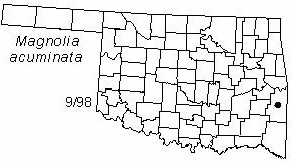
Tree to 18 m (60 ft) tall and 30 cm (12 in) diameter, with a narrow dense crown. Bark dark brown, divided into narrow scaly forking ridges. Twigs thick, brown or gray, becoming glabrous. Buds large (especially the end bud), oblong, soft-hairy. Leaves alternate, elliptical to ovate, 12-25 cm (5-10 in) long and 7.5-15 cm (3-6 in) wide, entire, acuminate, green and glabrous above, pale green and usually soft-hairy below. Flowers single at ends of twigs, bell-shaped, 6-9 cm (2.4-3.5 in) wide, with 6 greenish-yellow or yellow petals, blooming in Spring. Fruits conelike, oblong, 6-7.5 cm (2.4-3 in) long, composed of numerous follicles that split open in the late Summer to release two seeds.
Distribution: Found in scattered locations throughout the Appalachians, Ozarks, and Ouachitas.
Habitat: Moist upland oak-hickory forests. In the Ouachitas, it is usually found only on the upper north slopes of the highest mountains.
NWI status: none
Comment: Although the fruits are bitter, they are said to have been used in the past to flavor whiskey. Magnolia honors the French botanist and horticulturist Pierre Magnol; acuminata refers to the long-pointed leaf tips.
Distribution in Oklahoma: 
BACK
NEXT
RETURN TO INDEX
Last update: 9/14/99
 Go to Oklahoma Biological Survey Home Page
Go to Oklahoma Biological Survey Home Page
 Disclaimer
Disclaimer